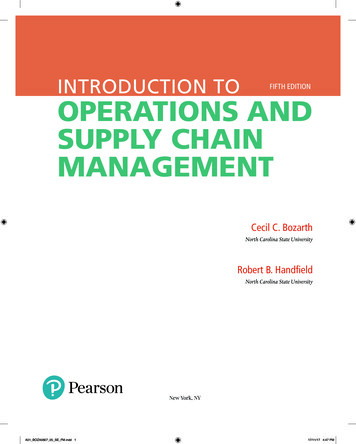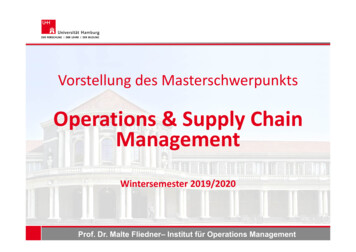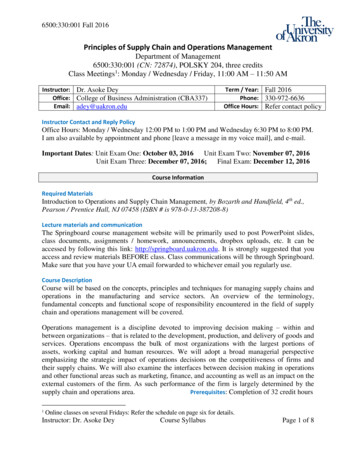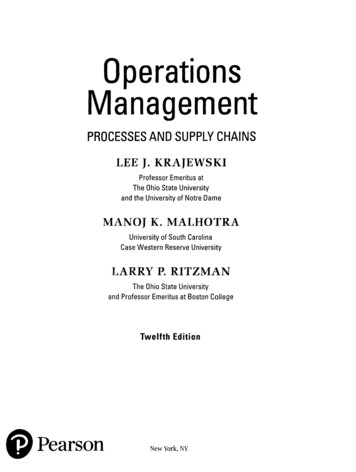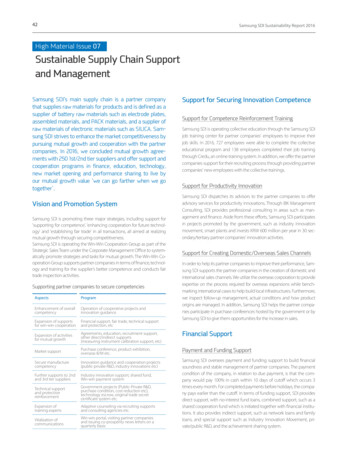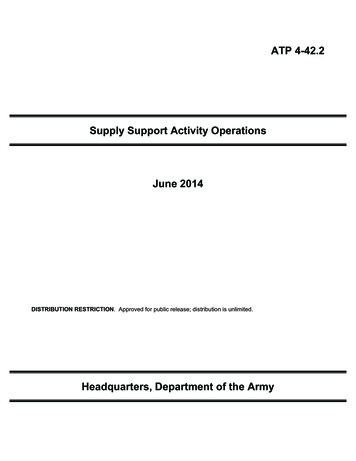
Transcription
ATP 4-42.2Supply Support Activity OperationsJune 2014DISTRIBUTION RESTRICTION. Approved for public release; distribution is unlimited.Headquarters, Department of the Army
This publication is available at Army Knowledge .html).To receive publishing updates, please subscribe athttp://www.apd.army.mil/AdminPubs/new subscribe.asp.
*ATP 4-42.2 (FM 10-15)HeadquartersDepartment of the ArmyWashington, DC, 9 June 2014Army Techniques PublicationNo. 4-42.2Supply Support Activity OperationsContentsPagePREFACE.iiiINTRODUCTION .ivChapter 1SUPPLY MISSION OVERVIEW . 1-1Supply and Storage . 1-1Support Requirements. 1-4Organizational Relationships . 1-5Roles and Responsibilities . 1-8Chapter 2ESTABLISH A SUPPLY POINT . 2-1Deploying to an Undeveloped Area. 2-1Deploying to a Developed Area . 2-8Chapter 3SUSTAINMENT OPERATIONS IN THEATER . 3-1Warehouse Operations. 3-1Performing Inventories . 3-8Tools and Equipment. 3-9Chapter 4REDEPLOYMENT. 4-1GLOSSARY . Glossary-1REFERENCES . References-1INDEX . Index-1FiguresFigure 1-1. Notional storage location with all storage types. 1-4Figure 1-2. Organizational relationships. 1-6Figure 2-1. Notional supply support activity (SSA) field layout plan. 2-2Figure 2-2. Field storage layout . 2-3Figure 2-3. Bin storage . 2-5Distribution Restriction: Approved for public release; distribution is unlimited.*This publication supersedes FM 10-15 dated 12 December 1990.i
ContentsFigure 2-4. Tent storage layout . 2-6Figure 2-5. Van storage layout . 2-7Figure 3-1. Properly loaded heavy load . 3-6Figure 3-2. Tail gate load . 3-7Figure 3-3. Forklifts . 3-10TablesTable 1-1. Classes of supply . 1-1iiATP 4-42.29 June 2014
PrefaceArmy Techniques Publication (ATP) 4-42.2, Supply Support Activity Operations, provides specific guidance onplanning, organizing, directing, coordinating, and controlling supply support. It is relevant to all logistics unitsat all levels. It is consistent with joint and multinational doctrine.The principal audience for ATP 4-42.2 is all members of the profession of arms. Commanders and staffs ofArmy headquarters serving as joint task force or multinational headquarters should also refer to applicable jointor multinational doctrine concerning the range of military operations and joint or multinational forces. Trainersand educators throughout the Army will also use this manual.Commanders, staffs, and subordinates ensure that their decisions and actions comply with applicable UnitedStates, international, and, in some cases host-nation laws and regulations. Commanders at all levels ensure thattheir Soldiers operate in accordance with the law of war and the rules of engagement. (See Field Manual [FM]27-10.)ATP 4-42.2 uses joint terms where applicable. Selected joint and Army terms and definitions appear in both theglossary and the text. For definitions shown in the text, the term is italicized and the number of the proponentpublication follows the definition. This publication is not the proponent for any Army terms.ATP 4-42.2 applies to the Active Army, Army National Guard/Army National Guard of the United States, andUnited States Army Reserve unless otherwise stated.The proponent of ATP 4-42.2 is the United States Army Quartermaster School. The preparing agency is UnitedStates Army Combined Arms Support Command G3 Training Support and Doctrine Directorate. Sendcomments and recommendations on a DA Form 2028 (Recommended Changes to Publications and BlankForms) to Commander, United States Army Combined Arms Support Command, ATTN: ATCL-TS (ATP 442.2), 2221 A Ave, Fort Lee, Virginia 23802; or submit an electronic DA Form 2028 by email mil.Unless this ATP states otherwise, masculine nouns and pronouns do not refer exclusively to men.9 June 2014ATP 4-42.2iii
IntroductionATP 4-42.2, Supply Support Activity Operations, replaces FM 10-15, Basic Doctrine Manual for Supply andStorage. FM 10-15 was published December 1990. There has been much advancement in strategic andoperational logistics processes and procedures in response to Army transformation and recent conflicts. ATP 442.2 contains new operational methods resulting from lessons learned and contains processes that did not existpreviously.The Army’s approach to logistics has changed significantly since FM 10-15 was published in 1990. The Armyis in the process of replacing SARSS with a web-based enterprise resource planning system called GlobalCombat Support System – Army thereby making nearly all of the FM 10-15 information obsolete.FM 10-15 provided information for supply officers and leaders in petroleum, water, technical supply as well assupply support activities. Each of these functions is being addressed in separate Army techniques publicationsmaking it no longer necessary to address in ATP 4-42.2, Supply Support Activity Operations. FM 10-15 had twosections:Part 1: Supply Officers and Leaders. This section contains information for supply operations officers, supplyplatoon leaders, petroleum platoon leaders and technical supply officers. With few exceptions, the informationpresented is operator level procedures rather than management level business practices.Part 2: Supply Operations. This section contains in-depth information on filling out manual forms and dataentry screens for Direct Support Unit Standard Supply System and Standard Army Retail Supply System –Interim.ATP 4-42.2 focuses on what Soldiers do rather than on the flow of digital information within the logisticsautomation systems. ATP 4-42.2 also focuses on aviation specific and multi-class supply support activityoperations rather than specific commodity supply points. This ATP does not address management or handlingof class III (bulk) or class V.Significant topics of this ATP are as follows: Chapter 1 explores the broad supply mission, supply and storage, support requirements, organizationalrelationships and roles/responsibilities. Chapter 2 explains the principles of establishing a supply point. Chapter 3 provides information on sustainment operations in a deployed environment. Chapter 4 offers insights for redeploying the supply support activity.ivATP 4-42.29 June 2014
Chapter 1Supply Mission OverviewSuccess throughout unified land operations depends on the Army’s ability to feed andclothe its forces, fuel its vehicles, arm its combat vehicles, fortify its positions, andreplace its major end items, and information systems. The following chapter exploresthe broad supply mission, supply and storage, support requirements, organizationalrelationships and roles and responsibilities.SUPPLY AND STORAGE1-1. Central to supply and storage is the provision of materiel to the Soldier on the battlefield. The termsinventory management, materiel control, materiel management, and supply chain management are similaras evidenced by the formal definition of each term in military literature. Inventory management is the phaseof military logistics that includes managing, cataloging, requirements determinations, procurement,distribution, overhaul, and disposal of materiel. According to joint doctrine, supply is the procurement,distribution, maintenance while in storage, and salvage of supplies, including the determination of kind andquantity of supplies (JP 4-0). These related terms are used to describe the process of providing for theSoldier on the battlefield.SUPPLY OPERATIONS1-2. Materiel refers to all items necessary to equip, operate, maintain, and support military activitieswithout distinction as to its application for administrative or combat purposes (JP 4-0). Inventory control,also called materiel management, encompasses the entire life-cycle from identifying a requirement for apiece of equipment to the disposal of that equipment. Army supply support is a subset of materielmanagement. Supply support is the process of providing all items necessary to equip, maintain, and sustainan operational force. In military terms, supply support can be defined as the receipt, storage, safeguarding,turn-in and issue of the various commodities referred to as classes of supply. The supply classes are the tencategories into which supplies are grouped in order to facilitate supply management and planning. The tenclasses of supply are shown in table 1-1.Table 1-1. Classes of supplyClass ISubsistenceClass IIClothing, Individual Equipment, Tools,Administrative SuppliesClass IIIPetroleum, Oils, LubricantsClass IVConstruction MaterialClass VAmmunition and ExplosivesClass VIPersonal Demand ItemsClass VIIMajor End ItemsClass VIIIMedical MaterialsClass IXRepair PartsClass XMaterial for Nonmilitary Programs1-3. Army materiel management operations are administered as a single logistics enterprise usingenterprise resource planning technology. One system automates the flow of information allowing users toshare common data, which promotes accountability and accurate visibility for logistics and financial9 June 2014ATP 4-42.21-1
Chapter 1planners. This technology integrates procedures associated with supply support operations from the tacticalto the national level by having one database for logistics and financial information.1-4. The successful supply support mission accomplishment depends, first, on human communication andsecond, on the automation of procedures. The Army uses sophisticated web based enterprise resourceplanning technology for receipt, storage operations, issue, and accountability of supplies throughout thesupply chain. Decisions can be made based on near real time supply data because every material movementhas a source and a destination associated with it. Information technology increases the level of precision inthe supply mission because it facilitates more accurate budgeting, planning and forecasting. Web basedsupply data arms commanders and their staffs with critical decision-making information for sustainingsupported units, whether in garrison or during military operations.1-5. Enterprise-wide forecasting, planning, and scheduling tools integrate supply support functions acrossthe Army to link customers and suppliers for more efficient supply chain management. A transaction flowsseamlessly from the customer to the supplier thereby providing timely, accurate, and accessible informationfor all users, to include the financial managers. Commanders at all levels can verify operation readiness innear real time because their material managers have access to logistics information that originates with thecustomer unit’s supply request through the entire supply chain until the customer receives his requesteditems. Material managers monitor on-hand stocks, requirements determination, procurement, maintenanceof stock, maintenance, disposal, retrograde, and distribution of materiel.1-6. The warehouse management module within the enterprise refers to the warehousing function.Storage location procedures and materials are managed using the inventory management and warehousemanagement modules. These two modules integrate to create an automated environment that displays thelocation of stock and quantities in each storage type at every storage location. Material managers use thematerial management module to provide oversight to enforce supply discipline using financial controls.1-7. Supply personnel require specialized training to operate this system. Soldiers may arrive withoutexperience or in-depth knowledge of the enterprise system. Untrained Soldiers will have a direct impact onthe supply support activity’s (SSA) ability to provide effective and efficient customer service. Arrangetraining schedules to ensure that operators and leaders are not involved in other events.1-8. Roles in the enterprise system are based upon existing positions, such as storage manager. Theseroles are divided vertically between management and clerical and horizontally between office andwarehouse. Roles determine what a user can see or do in the enterprise resource planning system. Userroles are defined by organizational element, for example, a unit cannot process SSA transactions or oneSSA cannot process transactions for another SSA. Each user role is authorized to execute a specificcombination of transactions and only those transactions relevant to that user’s level of responsibility.Depending on the level of responsibility required a user may perform duties which require multiple userroles.1-9. The Army executes supply operations below the national level via distribution centers also calledsupply points or SSAs. These distribution centers vary based on the category of supply each distributes.Unlike the more specialized supply points, SSAs handle multiple classes of supply. Each classification ofsupply requires maintaining a stock record account. By definition, a stock record account is a formal basicrecord showing, by item, receipt, issue, balance on hand, turn-in, and other necessary stock control data.1-10. All Army supply points maintain accountability and inventories of supplies required to support thereadiness of supported units. SSA management includes, but is not limited to, stocking the items needed forcustomer readiness, monitoring performance metrics, and conducting inventories. Typically, SSAs requestand receive materiel from the national level. National level supply centers consist of life cycle managementcommands, depots, and arsenals. Materiel may be Army managed or non-Army managed meaning thesource of supply may be a Department of the Army facility, another Service, or another Department ofDefense facility. There are rare instances in which an SSA may purchase directly from vendors. Directordering from vendors is the least preferred practice. All orders fulfillment involving a vendor as source ofsupply will be administered by the inventory control point manager (customer account specialist, weaponsystem support manager, or product specialist).1-2ATP 4-42.29 June 2014
Supply Mission OverviewSTORAGE OPERATIONS1-11. An SSA is a storage location within the enterprise. SSAs stock hundreds or even thousands ofproducts to meet the needs of supported units. Storage space is the most critical and basic resource of anySSA. The amount of storage space available is often limited; therefore, SSAs must make the best use of allavailable space. When bins run the same direction as the ends of the warehouse, receive items at one end ofthe warehouse and issue those items at the other end.1-12. The SSA is responsible for storing and safeguarding the materiel on its authorized stockage list(ASL), unprocessed inbound deliveries, customer materials slated for issue, and outbound materials slatedfor shipment. SSAs are also responsible for temporary storage of unserviceable items awaiting shipment tothe Defense Logistics Agency disposition services. Depending on the type of supplies and the facilities,specific safety and physical security measures must be taken to ensure that accountability is maintained. Allsupplies must be stored where the items will be protected from theft, fire, weather damage, rodents, andinsects. Supplies such as end items, repair parts, ammunition, petroleum products, and subsistence mayrequire special handling or storage conditions. Some products are hazardous if stored with other stock or ifstorage personnel handle them improperly. The SSA may also stock items that are considered sensitive dueto security classification, high desirability and/or are easily pilferable.1-13. Stock control is the process of maintaining inventory data on the quantity, location, and condition ofsupplies. Great care must be taken to account for all supplies. SSA stocks must be stored in a systematicmanner in order to be located quickly and easily for issue. The method of storage depends on the materialbeing stored. Each item must have a storage type that follows storage safety procedures and must be inaccordance with enterprise stock control measures. Monitor expiration dates and rotate stock to preventdeterioration of shelf life or waste of perishable items. Issue the oldest stock first. This is referred to as thefirst in, first out rule. Improper storage of shelf life items may lead to the loss of these items, whichamounts to a waste of Army resources. Shelf life will be impacted by storage practices and the climatewhere the storage facility is located.1-14. Store materiel in specific places to ensure that the items can be located quickly and easily for pickand return to storage. A storage type is a unique area within the storage location that is characterized by thespace it occupies and the way it is organized and could consist of one or more storage bins. A storage typeis simply an address for each item of stock that is stored in the storage location. All supply points are notthe same and a single SSA may or may not use all of the following storage types. Figure 1-1on page 1-4shows a notional storage location using all of these storage types: Pallet Storage. Shelf Storage. Rack Storage. Yard Open Storage. Drawer/Cabinet Storage. Hazardous Materials Storage. Container Storage. Van Storage. Physical Security Storage.9 June 2014ATP 4-42.21-3
Chapter 1Figgure 1-1. Notional storagee location wiith all storagge typesSUPPOORT REQUUIREMENTS1-15. Theater logistiics planners deevelop the theaater distributioon plan based ono the commannder’s operatioonplan, supportsconceppt, and operatiion orders. Thee theater distriibution plan inncludes organizzations from thhetacticaal SSA back too Department ofo Defense disttribution supply centers. The Army developps its operationnsplans for specifi
iv ATP 4-42.2 9 June 2014 Introduction ATP 4-42.2, Supply Support Activity Operations, replaces FM 10-15, Basic Doctrine Manual for Supply and Storage.FM 10-15 was published Decemb




